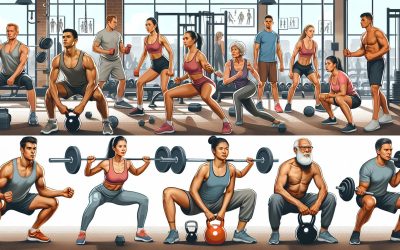Building a Solid Foundation for Beginners

Before and after Strength Training transformation.
Strength training is essential to any fitness routine, and building a solid foundation is critical to success.
Whether you’re a beginner or a seasoned athlete, understanding the basics of strength training is crucial to avoid injury and maximize results.
In this article, we’ll cover the fundamentals of strength training 101 and provide tips on how to build a strong foundation for your fitness journey.
Strength is the foundation of all fitness, and it’s essential to understand the science behind it.
Training is using resistance to build muscle and increase overall strength.
You can increase your muscle mass and improve physical performance by lifting weights or performing bodyweight exercises.
However, strength training is not just about lifting heavy weights; it’s about building a solid foundation of functional movement patterns to help you achieve your fitness goals.
Whether your goal is to build muscle, lose weight, or improve your athletic performance, strength training can help you get there.
By focusing on the basics and building a solid foundation, you can avoid injury and achieve long-term success.
So, let’s dive into strength training 101 and start building the foundation for a stronger, healthier you.
Understanding Strength Training
The Science Behind Muscle Building
Strength training is a type of physical exercise that uses resistance to improve muscle strength and endurance.
The science behind muscle building is quite simple.
When you lift weights or use resistance bands, you create tiny tears in your muscle fibers.
Your body then repairs these tears, strengthening your muscles and making them more resilient.
To build muscle effectively, you need to overload your muscles progressively.
It means gradually increasing the weight or resistance you use over time.
Overloading your muscles in this way stimulates the growth of new muscle fibers, leading to increased muscle mass and strength.
Benefits of Strength Training
Strength training offers a wide range of benefits for both physical and mental health. Here are some of the critical benefits of strength training:
- Increased muscle mass: Strength training helps build muscle mass, improving physical appearance and making everyday tasks easier. Improved muscle strength: Increasing your muscle strength can improve your overall physical performance and reduce your risk of injury.
- Better bone health: Strength training can help to improve bone density, reducing your risk of osteoporosis and fractures.
- Improved metabolism: Building muscle can help to increase your metabolism, making it easier to maintain a healthy weight.
- Reduced risk of chronic disease: Strength training has been shown to reduce the risk of chronic diseases such as heart disease, type 2 diabetes, and cancer.
- Improved quality of life: Regular strength training can improve your overall quality of life by increasing your energy levels, reducing stress, and improving your mental health.
By understanding the science behind muscle building and the benefits of strength training, you can begin to build a solid foundation for your fitness journey.
Focus on Form and Technique
The Importance of Proper Technique
Strength training, proper form, and technique are essential for maximizing results and preventing injuries.
Proper technique involves maintaining good posture, correct movement patterns, and adequate mobility.
Good posture is crucial for maintaining proper form during exercises. It helps to engage the correct muscles and prevent unnecessary joint strain.
Maintaining a neutral spine and keeping the shoulders down and back are examples of good posture.
Correct movement patterns involve using the right muscles to perform an exercise.
For example, the glutes and quads should be engaged during a squat, while the lower back should not be used excessively.
It ensures that the targeted muscles are being worked on and reduces the risk of injury.
Mobility is also essential for proper technique.
Adequate mobility allows for a full range of motion during exercises, which helps to engage the correct muscles and prevent compensations.
Stretching and foam rolling can help improve mobility and prevent injuries.
Common Mistakes and How to Avoid Them
One common mistake in strength training is using too much weight. It can lead to poor form and increase the risk of injury.
Using a weight that allows for proper form and technique is essential.
Another mistake is not warming up properly. A proper warm-up should include dynamic stretching and movements that mimic the exercises. It helps to prepare the muscles and joints for the workout.
Finally, rushing through exercises can also lead to poor form and injury. Taking the time to perform each exercise correctly and with control is essential.
To avoid these mistakes, starting with lighter weights and focusing on proper form and technique is essential.
Gradually increase the weight as proper form is maintained.
A proper warm-up and cool-down should be included in each workout.
Focusing on form and technique is essential for effective and safe strength training.
By maintaining good posture, using correct movement patterns, and having adequate mobility, individuals can achieve their fitness goals while minimizing the risk of injury.
Key Strength Training Exercises
Squats and Deadlifts
Squats and deadlifts are two of the most critical exercises in any strength training program.
Squats primarily work the lower body, including the quads, hamstrings, and glutes, while deadlifts target the back, glutes, and hamstrings.
Both exercises also work the core and improve overall strength.
It’s essential to maintain proper form to avoid injury when performing squats.
The feet should be shoulder-width apart, with the toes pointing slightly outward.
The knees should track over the toes, and the hips should push back as if sitting in a chair.
The back should remain straight, and weight should be distributed evenly throughout the feet.
Deadlifts are performed by standing with your feet shoulder-width apart and the barbell on the ground before you.
The knees should be bent, and the back should be straight as you grip the bar with an overhand grip.
Lift the bar by pushing through the heels and extending the hips until you’re standing upright. Lower the bar back to the ground with control.
Push and Pull Movements
Push and pull movements are essential for building upper body strength.
Push movements include push-ups, bench presses, and overhead presses, while pull movements include pull-ups, rows, and lat pulldowns.
Push-ups are a great bodyweight exercise that can be done anywhere.
Start in a plank position with your hands shoulder-width apart. Lower your body until your chest touches the ground, then push back to the starting position.
Rows are performed by bending over with a weight in each hand and pulling the weights toward your chest.
Lat pulldowns are performed by sitting at a machine with a bar overhead and pulling the bar down towards your chest.
Core Exercises
Core exercises are essential for overall strength and stability. Planks, sit-ups, and Russian twists are all practical core exercises.
To perform a plank, start in a push-up position, then lower down onto your forearms. Hold this position for as long as possible, keeping your body straight from head to heels.
Sit-ups are performed by lying on your back with your knees bent and your hands behind your head. Lift your upper body off the ground and towards your knees, then lower back down.
Russian twists are performed by sitting on the ground with your knees bent and your feet flat.
Hold a weight before your chest and twist your torso to one side, then to the other.
Incorporating these critical exercises into your strength training routine will help you build a solid foundation and improve overall strength and fitness.
Building Muscle Mass
Building muscle mass is a common goal for many individuals in strength training. Individuals can improve their strength, physical appearance, and athletic performance by increasing muscle mass.
It is essential to focus on two key factors: progressive overload and fueling your body for muscle growth.
Progressive Overload
Progressive overload is the gradual increase in stress placed on the muscles during exercise. Stress stimulates the muscles to adapt and grow stronger, increasing muscle mass.
To achieve progressive overload, individuals can increase the weight lifted, the number of repetitions performed, or the intensity of the exercise.
It is important to note that progressive overload should be applied gradually and consistently to avoid injury.
A sudden increase in weight or intensity can lead to muscle strains or other injuries.
Additionally, it is essential to vary the exercises performed to target different muscle groups and prevent plateaus in muscle growth.
Fueling Your Body for Muscle Growth
In addition to progressive overload, fueling your body for muscle growth is essential for building muscle mass. It means consuming enough calories and nutrients to support muscle growth and repair.
Protein is a crucial nutrient for building muscle mass, providing the building blocks (amino acids) for muscle tissue.
It is recommended that individuals consume 0.8-1.2 grams of protein per pound of body weight per day.
Carbohydrates are also crucial for fueling workouts and supporting muscle growth.
Complex carbohydrates, such as whole grains and vegetables, provide sustained energy for workouts and help replenish muscle glycogen stores.
Finally, healthy fats are essential for hormone production and overall health. Incorporating healthy fats, such as nuts, seeds, and avocado, into the diet can support muscle growth and overall health.
Overall, building muscle mass requires a combination of progressive overload and proper nutrition.
Individuals can achieve their muscle-building goals by gradually increasing the stress on the muscles and fueling the body with adequate nutrients.
Recovery and Injury Prevention
The Role of Rest and Recovery
Rest and recovery are essential components of any strength training program.
Adequate rest is necessary to allow the body to repair and rebuild muscle tissue damaged during exercise.
Without sufficient rest, the body may become overtrained, leading to decreased performance, increased risk of injury, and other adverse effects.
In addition to rest, recovery also involves proper nutrition and hydration. The body needs fuel and nutrients to repair and rebuild muscle tissue, so eating a balanced diet with plenty of protein, carbohydrates, and healthy fats is essential.
Staying hydrated is also crucial for recovery, as water helps transport nutrients to the muscles and flushes out waste products.
Preventing and Managing Injuries
Despite taking precautions, injuries can still occur during strength training. However, some steps can be taken to prevent and manage injuries.
One of the most important things is to start with a proper warm-up. It helps prepare the muscles for exercise and reduces the risk of injury.
A warm-up should include light aerobic exercise, stretching, and dynamic movements that mimic the exercises.
Proper form is also crucial for injury prevention. Using improper form can place unnecessary stress on the joints and muscles, increasing the risk of injury.
It’s essential to use proper technique and to start with light weights before progressing to heavier loads.
If an injury occurs, seeking medical attention and following a proper rehabilitation program is essential. It may include rest, ice, compression, elevation (RICE), physical therapy, and other treatments.
By prioritizing rest and recovery and taking steps to prevent and manage injuries, individuals can build a solid foundation for a successful strength training program.
Strength Training for Different Populations
Strength Training for Older Adults
Strength training benefits older adults as it helps maintain muscle mass and bone density, which can decrease with age. However, it is essential to remember that older adults may have limitations and should consult their healthcare provider before starting a strength training program. Here are some tips for older adults looking to start a strength training program.
- Start with light weights and gradually increase as strength improves.
- Focus on exercises that target major muscle groups such as the chest, back, legs, and arms.
- Incorporate balance exercises to reduce the risk of falls.
- Use machines or resistance bands instead of free weights to reduce the risk of injury.
Strength Training for Those with Health Conditions
Strength training can also benefit those with health conditions such as osteoporosis, diabetes, arthritis, and obesity. However, consulting a healthcare provider before starting a strength training program is essential. Here are some tips for those with health conditions:
- For those with osteoporosis, focus on exercises that target the hips, spine, and wrists to improve bone density.
- For those with diabetes, strength training can help improve insulin sensitivity and blood glucose control.
- For those with arthritis, focus on low-impact exercises that put less stress on the joints, such as swimming, cycling, and using resistance bands.
- For those with obesity, strength training can help increase muscle mass and boost metabolism.
Training can benefit older adults and those with health conditions. However, consulting with a healthcare provider before starting a program and focusing on exercises appropriate for individual limitations and goals is essential.
Advanced Strength Training Techniques
Conditioning Workouts
Advanced strength training techniques often involve incorporating conditioning workouts into your routine. These workouts are designed to improve cardiovascular endurance and overall fitness. They can also help you burn more calories and improve your body composition.
Some popular conditioning workouts include high-intensity interval training (HIIT), circuit training, and plyometrics. HIIT involves short bursts of intense exercise followed by periods of rest or lower-intensity exercise.
Circuit training involves performing back-to-back exercises with little to no rest. Plyometrics involves explosive movements such as jumping and bounding.
Incorporating conditioning workouts into your routine can help you break through plateaus and improve your fitness. However, starting slowly and gradually increasing your workouts’ intensity and duration is essential to avoid injury.
Resistance Training
Resistance training is another advanced strength training technique that can help you take your workouts to the next level. This type of training involves using weights or other forms of resistance to challenge your muscles and improve your strength.
Some popular forms of resistance training include bodyweight exercises, free weights, and weight machines. Bodyweight exercises include push-ups, pull-ups, and squats. Free weights include dumbbells and barbells. Weight machines are designed to target specific muscle groups and can be found in most gyms.
When incorporating resistance training into your routine, focusing on proper form and technique is essential to avoid injury. It’s also important to gradually increase your weight or resistance to continue challenging your muscles and making progress.
Incorporating conditioning workouts and resistance training into your routine can help you achieve your fitness goals and build a solid foundation of strength. However, it’s essential to consult with a qualified fitness professional before starting any new exercise program to ensure you’re using the proper form and technique.
Conclusion
In conclusion, building a solid foundation is crucial for any strength training program. By starting with the basics and gradually increasing the intensity and complexity of exercises, one can adapt to the demands of strength training and avoid injury.
Focusing on proper form and technique is essential, rather than just lifting heavy weights. It will ensure that the targeted muscles are being worked effectively and reduce the risk of injury.
In addition, incorporating various exercises and progressive overload can help prevent plateaus and continue making progress. It can include using different equipment, changing the number of sets and reps, and increasing weight as strength improves.
Strength training can have numerous benefits for physical and mental health. Individuals can achieve their fitness goals and improve their well-being by building a solid foundation and adapting to the program’s demands.
Summary
“From Confusion to Clarity: Strength Training,” this insightful article takes readers on a transformative journey through the fitness world.
It is a comprehensive guide to help individuals transition from uncertainty about strength training to a place of absolute clarity.
By demystifying the essential concepts, techniques, and benefits of strength training, this article empowers readers to embark on their fitness journey with confidence.
Whether you’re a seasoned fitness enthusiast or a newcomer to the world of exercise, “Strength Training” is your key to achieving physical and mental clarity, guiding you towards a stronger, healthier you.
Wrap-Up
Ready to take the first step toward a stronger, healthier you? Dive into the world of strength training with our comprehensive guide. Click the link below to access “Strength Training 101” and start your journey from confusion to clarity today. Your body will thank you
My Best to You,
Elizabeth Redd
Join my Facebook Community: Click Here
elizabethredd179.s@gmail.com
https://healthandhealingai.com
P. S. Are you ready to open your eyes to a New Thing
P. S. Don’t let confusion hold you back any longer. Discover the power of strength training and unlock a more straightforward path to fitness.
“Strength Training” now and embark on a transformative journey towards a stronger, more vibrant you.
Your future self will be grateful for the decision you make today.
Elizabeth Redd: I am a passionate advocate for Health and Healing, dedicated to empowering individuals to live their best lives.
As the founder and publisher of Health and Healing, I have established myself as a guiding force in the wellness industry.
I am committed to providing the latest research, holistic approaches, and inspiring stories to open new possibilities for your health and healing journey.
Learn more about Elizabeth and Join Us at Health and Healing. Also, check out My About Page.





0 Comments